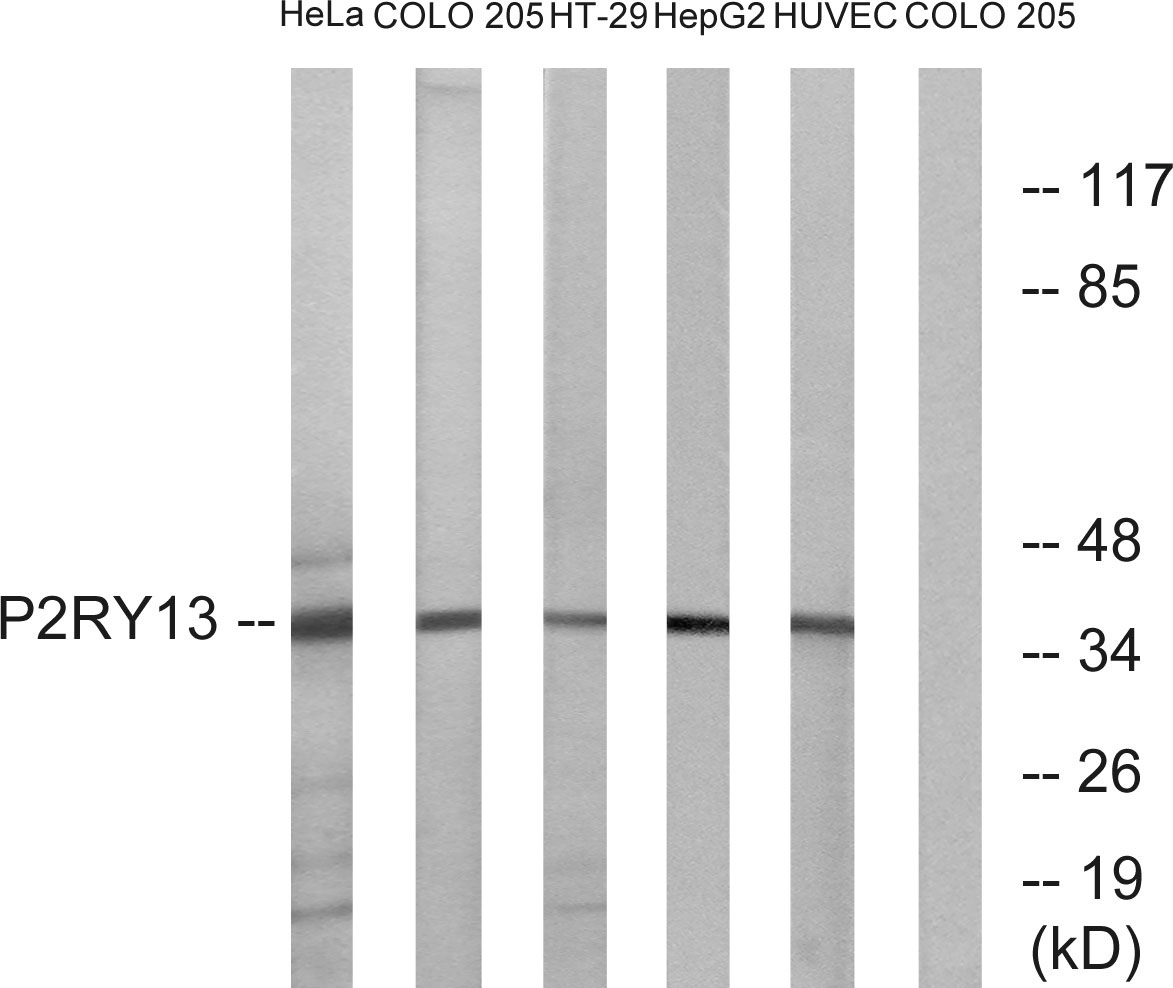P2RY13 Polyclonal Antibody
- Catalog No.:YT3503
- Applications:IHC;IF;WB;ELISA
- Reactivity:Human;Rat
- Target:
- P2RY13
- Fields:
- >>Neuroactive ligand-receptor interaction
- Gene Name:
- P2RY13
- Protein Name:
- P2Y purinoceptor 13
- Human Gene Id:
- 53829
- Human Swiss Prot No:
- Q9BPV8
- Mouse Swiss Prot No:
- Q9D8I2
- Rat Gene Id:
- 310444
- Rat Swiss Prot No:
- Q6GUG4
- Immunogen:
- The antiserum was produced against synthesized peptide derived from human P2RY13. AA range:209-258
- Specificity:
- P2RY13 Polyclonal Antibody detects endogenous levels of P2RY13 protein.
- Formulation:
- Liquid in PBS containing 50% glycerol, 0.5% BSA and 0.02% sodium azide.
- Source:
- Polyclonal, Rabbit,IgG
- Dilution:
- WB 1:500 - 1:2000. IHC 1:100 - 1:300. IF 1:200 - 1:1000. ELISA: 1:20000. Not yet tested in other applications.
- Purification:
- The antibody was affinity-purified from rabbit antiserum by affinity-chromatography using epitope-specific immunogen.
- Concentration:
- 1 mg/ml
- Storage Stability:
- -15°C to -25°C/1 year(Do not lower than -25°C)
- Other Name:
- P2RY13;GPR86;GPR94;FKSG77;P2Y purinoceptor 13;P2Y13;G-protein coupled receptor 86;G-protein coupled receptor 94
- Observed Band(KD):
- 38kD
- Background:
- The product of this gene belongs to the family of G-protein coupled receptors. This family has several receptor subtypes with different pharmacological selectivity, which overlaps in some cases, for various adenosine and uridine nucleotides. This receptor is activated by ADP. [provided by RefSeq, Sep 2008],
- Function:
- function:Receptor for ADP. Coupled to G(i)-proteins. May play a role in hematopoiesis and the immune system.,miscellaneous:Stimulation by ADP in stably transfected CHO cells resulted in inhibition of adenylyl cyclase and the phosphorylation of the MAP kinases MAPK3 and MAPK1 in a pertussis toxin-sensitive way. Inhibition of adenylyl cyclase and phosphorylation of the MAP kinases are transduction mechanisms that involve G(i) proteins.,sequence caution:Contaminating sequence. Potential poly-A sequence.,similarity:Belongs to the G-protein coupled receptor 1 family.,tissue specificity:Strong expression in spleen and adult brain. Lower expression in placenta, lung, liver, spinal cord, thymus, small intestine, uterus, stomach, testis, fetal brain, and adrenal gland. Not detected in pancreas, heart, kidney, skeletal muscle, ovary or fetal aorta. Clearly detected in lymph node and bone marrow, w
- Subcellular Location:
- Cell membrane; Multi-pass membrane protein.
- Expression:
- Strong expression in spleen and adult brain. Lower expression in placenta, lung, liver, spinal cord, thymus, small intestine, uterus, stomach, testis, fetal brain, and adrenal gland. Not detected in pancreas, heart, kidney, skeletal muscle, ovary or fetal aorta. Clearly detected in lymph node and bone marrow, weakly detected in peripheral blood mononuclear cells (PBMC) and in peripheral blood leukocytes (PBL), but not detected in polymorphonuclear cells (PMN). In the brain, detected in all brain regions examined.
- June 19-2018
- WESTERN IMMUNOBLOTTING PROTOCOL
- June 19-2018
- IMMUNOHISTOCHEMISTRY-PARAFFIN PROTOCOL
- June 19-2018
- IMMUNOFLUORESCENCE PROTOCOL
- September 08-2020
- FLOW-CYTOMEYRT-PROTOCOL
- May 20-2022
- Cell-Based ELISA│解您多样本WB检测之困扰
- July 13-2018
- CELL-BASED-ELISA-PROTOCOL-FOR-ACETYL-PROTEIN
- July 13-2018
- CELL-BASED-ELISA-PROTOCOL-FOR-PHOSPHO-PROTEIN
- July 13-2018
- Antibody-FAQs
- Products Images

- Western blot analysis of lysates from HeLa, COLO, HT-29, HepG2, and HUVEC cells, using P2RY13 Antibody. The lane on the right is blocked with the synthesized peptide.



